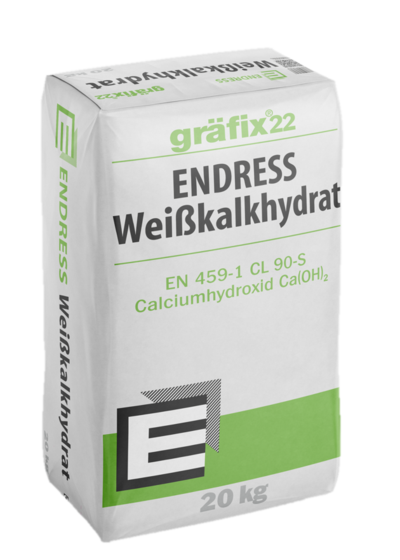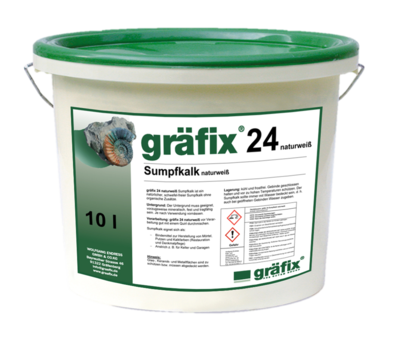gräfix 21
White lime CL 90-Q (white fine lime)
ground, unslaked
(calcium oxide, CaO)
gräfix 21 is used in slaked form as slaked lime for masonry and plaster production, for whitewashing ceilings and walls. Furthermore, the white fine lime is used for the production of aerated concrete, for soil stabilisation and in sewage treatment plants, power stations and waste incineration plants.
Delivery: 25 kg bag
- Lime according to DIN EN 459-1 CL 90 - Q
- Ground, unslaked white lime
- Grinding fineness: min. 95 % < 0.09 mm
- Yield: approx. 36 dm³/10 kg
- Without hydraulic components
- Delivery in 25 kg paper bag
- 40 bags per pallet/1.0 tonne
Composition:
- CaO + MgO: > 90 %
- MgO: approx. 1.5 %
- Sulphate as SO3 approx. 0.7 %
- Carbon dioxide CO: approx. 0.5 %
- Water of crystallisation: approx. 1.3 %
- Loss on ignition: approx. 1.9 %
- Analyses according to DIN EN 459-2, section 3
- in slaked form as lime putty
- for the production of mortars and plasters
- as white fine lime
- for the production of aerated concrete
- for soil stabilisation
- for use in sewage treatment plants, power stations, waste incineration plants
Lime for construction, industry and the environment
Around a third of all quicklime produced in Germany is supplied to the iron and steel industry, where high-quality lime products are used in the production of iron ore, pig iron and crude steel, removing unwanted by-products. Lime is also used in the extraction of iron and steel, gold, silver, copper and uranium, as well as in the manufacture of chemical products.
However, the lime industry's oldest customer is the construction industry.
Lime was already being used systematically by the Romans, who achieved an almost industrial standard in kiln technology. Today, lime is used as sand-lime bricks or aerated concrete in wall construction and holds the bricks together in lime-based mortar. As an aggregate, it is added to various building materials and improves the properties of concrete as an additive. Its building biology properties are dealt with separately. The use of hydrated lime in asphalt is a new addition to lime. According to American studies, the adhesion between the minerals and the binders as well as the ageing capacity (embrittlement) of the bituminous mortar is improved by adding hydrated lime to the asphalt. Hydrated lime in asphalt leads to more stability, fewer ruts, in short: to durable roads.
In the environment, lime plays a decisive role in waste gas and waste water purification, the binding of acid gases,CO2 and deacidification, i.e. raising the pH value. Lime applied to agricultural land and forest soils improves them and helps to enrich them with nutrients.




